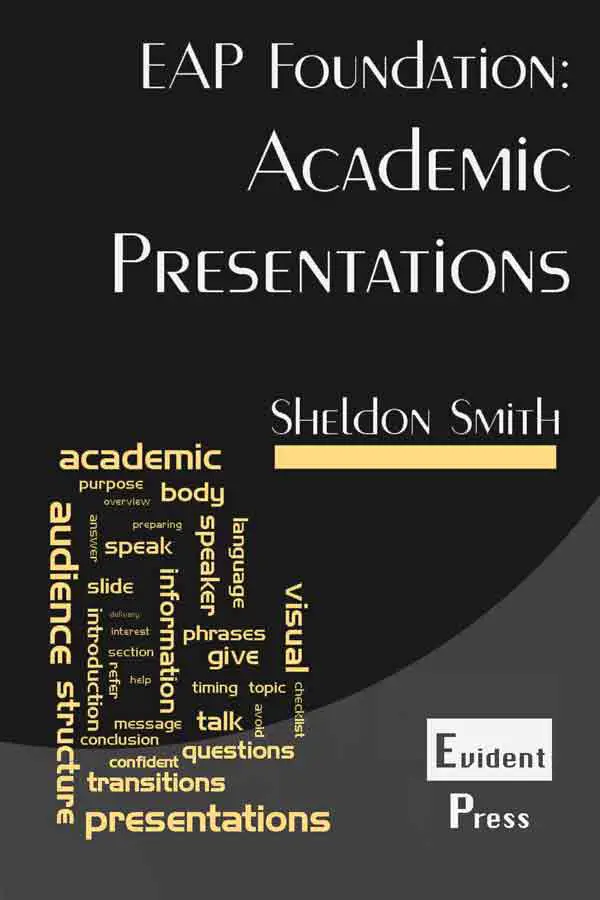Show AWL words on this page.
Show sorted lists of these words.


 







|
 Podcast is loading. Problems? Too slow? You can also access the Podcast by
clicking here.
Podcast is loading. Problems? Too slow? You can also access the Podcast by
clicking here.This message will disappear when then podcast has fully loaded.
The general structure of a presentation is much like any other academic work, such as an essay or a lecture. It too has an introduction, a main body, and a conclusion. Unlike an essay or a lecture, it has a final section at the end, the Q&A, when you will answer questions from the audience. The general structure of a presentation is shown in the following diagram. Each area is discussed in more detail below.
Introduction
The introduction is a vital part of your presentation. It must arouse the interest of the audience, provide them with a clear idea what the topic is and what you hope to achieve (your purpose), as well as explaining how the presentation will be organised (the structure). You also need to greet the audience and introduce yourself, say how long your presentation will be, and say when you will be answering questions.
In short, in the introduction to your presentation, you need to:
- greet the audience
- introduce yourself and the topic
- arouse interest - ask a question, tell a story
- state the purpose of the presentation
- outline the structure of the presentation - tell them what you are going to tell them
- say how long the presentation will last
- say when you will be answering questions (Q&A)
Main body
The main body presents the ideas which will achieve the purpose you stated in the introduction. You need to be selective about the material you will present in order to keep to the limited time available. You also need to make sure you maintain the audience's interest and understanding. This is achieved by presenting the information in a clear and logical sequence, emphasising the main points, and by making the structure clear by using signpost phrases to mark the transitions between sections. Visual aids will also be an important part of your main body, so you need to plan these well.
In short, in the main body of your presentation you should:
- present important data/material - be selective
- use signpost phrases to help the audience follow your ideas
- draw the audience's attention to important points
- plan visual aids to reinforce the verbal message
Conclusion
The conclusion should provide a strong and clear end to your presentation. This is the part the audience will remember most clearly. It provides a chance for you to review the main purpose of your presentation, and show how this has been achieved. You need to summarise the main points. You should emphasise what the audience has learnt, and what you want them to remember, ideally giving them a final 'take-away' message which is the one main idea you want them to remember from your presentation.
In short, in your conclusion you need to:
- review the purpose of your presentation - how did you achieve it?
- give a brief summary of the major points of the main body - tell them what you told them
- give a final 'take-away' message - what one thing do you want them to remember?
See the language for presentations section for language phrases for these functions.
Q&A
The Q&A session is the interactive part of your presentation: the one-way traffic of you talking to the audience now becomes two-way as they ask you for more information or to clarify some of your points. The Q&A can be intimidating, as you do not know what questions your audience will ask. You can help with this by anticipating questions as you prepare your presentation, and make sure you thoroughly research your topic. It is important to make sure you understand the question; a good technique is to repeat or rephrase the question to check ('Do you mean...?'). If you really do not know the answer, say so, but inform the questioner that you will do more research and answer the question later.
In short, you should:
- invite questions at the end of your presentation
- think of questions you might be asked when you are preparing your talk
- research the topic widely to help you answer questions more easily
- make sure you understand the question - repeat the question if you are not sure
- don't be afraid to say you don't know - but make it clear you will answer the question later
Checklist
Below is a checklist for structure. Ask a peer to use it to assess you when you practise. You can download a copy of the checklist from the speaking resources page.
| Item | OK? | Comments |
In the introduction, the speaker:
|
||
In the main body, the speaker does the following:
|
||
In the conclusion, the speaker:
|
||
In the Q&A section, the speaker:
|
Next section
Read more about presentation language in the next section.
Previous section
Go back to the presentations main page.
Exercises & ActivitiesSome ways to practise this area of EAP
You need to login to view the exercises. If you do not already have an account, you can register for free.



